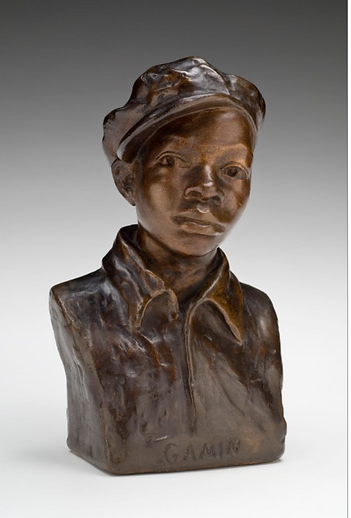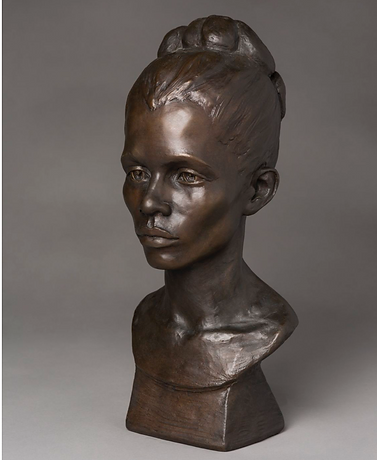
Artists From The Edge
AUGUSTA SAVAGE (1892-1962)

Augusta Savage. The Harp, 1939.
To say that Augusta Savage was resourceful would be an understatement. Throughout her life, she was a sculptor, a steam laundress, a farmer, a lab assistant and, above all, a teacher and a mentor. She had to demonstrate extraordinary skill and perseverance to survive all the difficulties she had to face – nevertheless, she persisted. She fought poverty, racism, and sexual discrimination to become one of America's most influential twentieth-century artists. Her sculptures celebrate African American culture, and her work as an arts educator, activist, and Harlem Renaissance leader catalysed social change.
Augusta Savage's Work
Augusta Savage’s most famous artwork is the Harp, which shows a choir of black singers. The work reinterpreted the musical instrument to feature 12 singing African-American youth in graduated heights as its strings, with the harp's sounding board transformed into an arm and a hand. In the front, a kneeling young man offered music in his hands. The composition is based on “Lift every voice and sing”, It has been called the “Negro national anthem” – a poem written by James Weldon Johnson in 1900. The Harp had a central location at the 1939 World’s Fair in New York.
At the time, Augusta Savage was the only black woman to be commissioned for the fair – she was paid just $360. The 16ft tall sculpture was destroyed by bulldozers when the fair closed. She had nowhere to store the work and no one wanted to buy it.
All that remains is a replica of a souvenir that existed at the time. It was apparently one of the most popular works in the fair, seen by over 5 million people.

Augusta Savage. The Gamin
Savage's 1929 sculpture Gamin, shows a child in a soft cap and wrinkled shirt. For her, bronze was too expensive, so instead Savage made her sculptures with white plaster covered with brown paint mixed with shoe polish. This work presented an African American child in a realistic and humane fashion. Thousands of kids saw Gamin on exhibit, seeing themselves for the first time as fine art.


The sculpture Realization from 1939, shows a black couple crouched in oppression. What is being realised in this piece is slavery. It’s about the psychological trauma of the moment after this couple had been sold. Trauma is difficult to depict in art, because trauma is about having to accept the unacceptable. One can depict the adjustment after acceptance or depict post-traumatic stress. But to capture that moment is the genius of Realization.
Augusta Savage strived towards a different type of monument. Many slavery monuments are about abolition and emancipation – this was a different way to remember slavery.
Unfortunately, like so much of Augusta’s artwork, it no longer exists today.

Augusta Savage. Gwendolyn Knight.
Augusta unveiled this bust in an exhibition of the works of her students at the Harlem Art Workshop in 1935. The subject is one of those students, the young artist Gwendolyn Knight.
There is a sense of introspection in Augusta's portrayal. Knight was a muse to many artists. She married painter Jacob Lawrence, a fellow student of Augusta, in 1941. As Knight’s mentor, Augusta became a source of inspiration in her promotion of African-American culture, and she encouraged Knight to work at the Harlem Community Arts Center. During these workshop years, Knight became associated with leading writers and activists of the Harlem Renaissance, such as the poet Langston Hughes and the artist Romare Bearden.
Augusta Savage's Legacy
Augusta Savage divided her time between artmaking and activism, both equally important in her life. Looking for a space in which black artists can thrive in America, she found none. So, the artist had to quite literally construct that space herself. Her brilliant students, artists like Gwendolyn Knight, Charles Alston and Jacob Lawrence, reflect her influence and impact. It is a fact that Savage until recently was not regarded as a mainstream Harlem Renaissance figure. The likely explanation is that her actual art is either missing or destroyed.
Augusta Savage's groundbreaking works were a leap forward for women of colour in the world of art. In 1939, she was the first African American woman to open her own art gallery in America – the Salon of Contemporary Negro Art. Devoted to showcasing the work of black artists, 500 people poured into the opening reception, where Savage announced: “We do not ask any special favors as artists because of our race. We only want to present to you our works and ask you to judge them on their merits.”
With her own struggle to get an education, Augusta devoted her life to teaching other black artists how to sculpt, draw and paint. She said her legacy is in the work of her students. When they didn’t have money to buy their own art supplies, she let them use hers, " knowing how much I was put down and denied. If I could teach these kids anything, I was going to teach it to them."
Augusta Savage was a social pioneer – not only did her art move viewers with its realistic approach to black identity, it also aimed to shake the status quo, which, until then, only saw black life and its manifestations in art as a commodity, an empty vessel through which to express something entirely different. Having spent most of her life in a society still espousing Jim Crow laws and racial segregation, Savage got the worst side of the coin; she was both African American and a woman, living in the early 20th century United States. Nevertheless, she managed to have a powerful, dismantling impact on the damaging institutions that were set up against her.
Her legacy lived on through the work of many black artists including the sculptor Charles Alston, one of Augusta’s students famed for his bust of Martin Luther King Jr, which was the first artwork of an African American in the White House. He also established the Harlem Artists Guild, which helped create career opportunities for black artists, and continued Savage’s legacy for civil rights activism through art.